- EraPharaonic
- Project DirectorDr. Nicholas Warner
- LocationLuxor
- AffiliationAmerican Research Center in EgyptMinistry of Tourism and Antiquities United States Agency for International Development (USAID)
- Project SponsorAmerican Research Center in EgyptUnited States Agency for International Development (USAID)
- Project DatesOctober 2021 - Present

Written by: Sally El Sabbahy, Bianca van Sittert, and Nicholas Warner
For ten years, from 2008 to 2018, ARCE undertook a series of conservation interventions aimed at revitalizing the New Kingdom-period Khonsu Temple on Luxor’s East Bank.
The entirety of this decade-long effort was made possible with generous funding by the United States Agency for International Development (USAID), through a technical on-the-job training program for Egyptian conservators from the Ministry of Tourism and Antiquities (MoTA), as well as several seasons of conservation and photography field schools for inspectors.
The physical outputs of this program were the consolidation and treatment of six of the temple’s twelve chapels and the selective restoration of sandstone flooring and decorated wall surfaces. This long-term program had the result of raising the standard of documentation and conservation for a large number of graduates from the field school, many of whom continue to use their enhanced skills at heritage sites around Egypt.
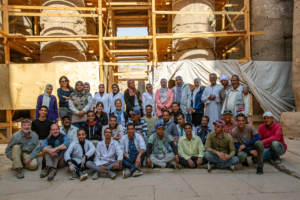
Khonsu Temple Conservation Project Team – December 2023. Photo by Frank Helmholz
In 2020, ARCE’s Board of Governors approved the continuation of conservation work at the temple under the financial umbrella of ARCE and with the additional support of its network of individual donors. The project is under the direction of the architect, Nicholas Warner, and is carried out annually over two seasons, fall and spring, each of a three-month duration.
In the fall of 2020, conservator Theo Gayer Anderson, who had previously worked with ARCE on its project at Bab Zuwayla, traveled to Luxor to produce an in-depth conservation assessment of the temple in order to inform a broader conservation strategy for the future. One year later, in the fall of 2021, CPT Studio Roma was contracted by ARCE to produce a full 3D digital capture of the temple, complete with orthophotographic and CAD outputs. A video flythrough was also generated from this work.
Following this comprehensive documentation of the temple’s condition, physical conservation work began in the fall of 2022, with fine conservation of the columns, ceilings, and walls in the north-west of the temple’s first court.
This effort was led by conservators Bianca Madden, Catherine Pille, Agustin Gamarra, Ahmed Gad, Marwa Hassan, and Ahmed Sallam. In the spring of that same year, efforts expanded to replacing previous poor quality stone repairs in the temple’s east pylon and roof, under the supervision of master mason James Wheeler.
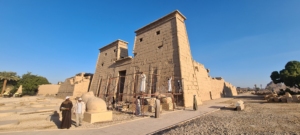
Consolidation of Eastern Pylon of Khonsu Temple (Photo: Theo Gayer-Anderson)
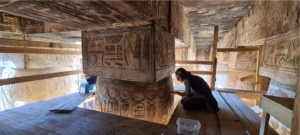
Conservator Catherine Pille at work on a column (Photo: Theo Gayer-Anderson)
As the fall 2022 season continued, an advanced training in the digital documentation of architectural remains kicked off in January 2023, under the supervision of Dr. David A. Anderson and Dr. Dina Bakhoum.
Eight inspectors from MoTA participated and the objective of the training was not only to strengthen the existing skills of the inspectors in photogrammetric documentation and 3D modeling, but ultimately to contribute towards a longer-term goal of ARCE’s project, which is the reconstruction of the remains of the temple’s Barque Shrine. Accordingly, the practical focus for the trainees was on documenting and creating plan views and animated 3D models of the surviving granite blocks of the Barque Shrine.
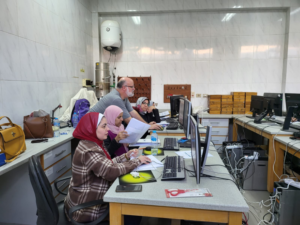
Dr. David A. Anderson and inspectors AlShaimaa Mohamed, Esraa Salem, and Hagar Ahmed during the advanced training in the digital documentation of architectural remains (Photo: ARCE Staff)
Spring 2023 saw a concentration of 2022’s work, with the conservators and stone masons continuing their efforts on the roof and extending into other areas of the temple, such as Chapel 8. Other external partners also came on board to provide specialist services, including Cintec International, who implemented the structural pinning of the temple’s roof and staircase, and the Epigraphic Survey of the Oriental Institute, University of Chicago – a long-time partner at the temple.
As part of the latter collaboration, Oriental Institute artist Dominique Navarro and epigrapher Ariel Singer worked to document inaccessible reliefs on the interiors of the temple’s reused structural blocks. USAID was another long-standing partner to return to the project, financing the reconstruction of the mud brick enclosure wall of Nectanebo I, located directly west of the temple, and the building of a new magazine for the storage of Talatat blocks hidden behind it.

Conservators working on the western section of the roof of Khonsu Temple (Photo: Hani el Taiyyib)

Epigrapher Ariel Singer (Chicago House) investigates a hidden relief (Photo: Theo Gayer-Anderson)
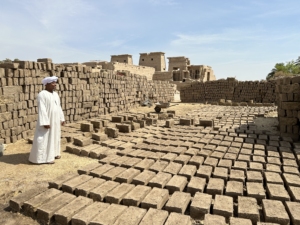
Reis Mahmoud al Quftawy at the Mudbrick production area for the reconstruction of Nectanebo I’s perimeter wall (Photo: ARCE Staff)

Computer-generated projection of new Talatat magazine in Karnak- Credit: MADA Architects
The 2023 -24 season continued the planned replacement of deteriorated stonework in the temple’s west pylon, with a team led by master mason Frank Helmholtz. Mason Johannes Weninger completed the program of installing sandstone roof-lights above the chapels, together with a large replacement roofing block over the staircase to the roof.
A new protective, reversible, and lightweight steel roof was also installed over the central axis of the first court leading to the hypostyle hall. The fine conservation of the northernmost section of the first court was completed, bringing to light many unknown details that shed light on the temple’s construction and sequence of decoration. Gayer-Anderson also began the task of re-assembling fragments from the Barque Shrine, making fifteen joins in this material.
The recently awarded USAID CHT II grant will also pave the way for the eventual conservation of the temple’s long-hidden west wall, with the demolition of the existing Pennsylvania Talatat Magazine that abuts this side of the temple being slated for the end of 2024.
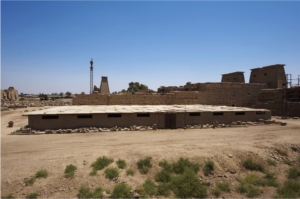
The “University of Pennsylvania” Talatat Block store built in 1962 on west flank of Khonsu temple (Photo: ARCE Staff)
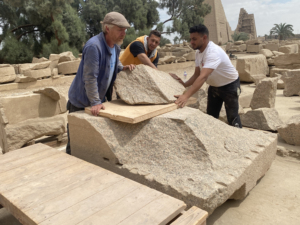
Conservators Theo Gayer-Anderson, Hassan Mostafa Abd Elaty, and Ahmed Mohamed Mahmoud Kurayem joining two fragments from the Barque Shrine of Khonsu Temple (Photo: Dominique Navarro)
Like the cathedrals of Europe, the temples of Egypt need constant care. The conservation of Khonsu Temple commenced in the 1890s and has continued on a sporadic basis since then. Some of the present work of ARCE addresses the use of inappropriate materials (such as cement) in this earlier work, as well as structural conservation that is often ignored in favor of the treatment of decorated surfaces.
The current main goals of the project are to complete the conservation of the pylon and west exterior wall of the temple, as well as all the decorated walls, columns, and ceilings in the first court. A new safe space for visitors to the roof of the temple, from where a magnificent view of Karnak can be appreciated, is also nearing completion.
This webpage is made possible by the generous support of the American people through the United States Agency for International Development (USAID). The contents are the responsibility of the American Research Center in Egypt and do not necessarily reflect the views of USAID or the United States Government.